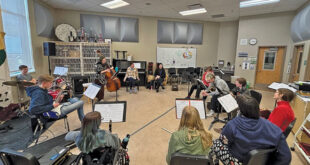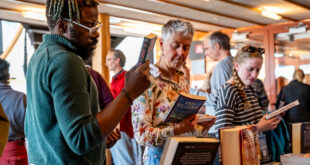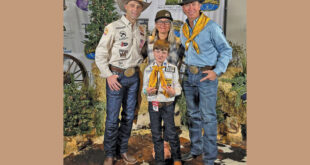Crested Butte — a mountain wonderland characterized by its rich ethnic culture, the beautiful Elk Mountains, its coal mines and music, highlighted by the polka and accordion. Bands with members with names like Spritzer, Bryan, Saya, Sallinger, Mraule and today’s Pete Dunda played every weekend and holiday in Crested Butte and the surrounding area. The music involved ethnic dances from the Old Country — Italy, Slovenia, Slovakia, Austria and Croatia — the polka, waltz, Schottish — and always there was the accordion as the major instrument of all the bands.
Return with us now to the days of yesteryear when the accordion reigned supreme and the sounds of the Beer Barrel polka and La Paloma Blanca echoed in the night air in the Grubstake, Kochevar’s, Tony’s Tavern, and other saloons of Crested Butte. But wait — let’s let the accordion tell its own story.
Buttons, bellows and ivories
I would like to be able to tell you precisely where I was born and when I came into existence in the musical world. However, there is controversy as to my country and my true date of birth. After some extensive research and digging, I discovered the following facts and history of my humble beginning.
Cyril Damian, an Armenian living in Vienna, patented me in Paris on May 6, 1829, where I was described as a small four-octave instrument that was to be the basis for the development of an absolutely revolutionary musical instrument (ME!). Others will say I was born in 1822 via a German instrument maker, Christian Buschmann, who placed bellows onto a small portable keyboard with free vibrating reeds. Christian and I embarked on travels throughout south-central Europe in 1828 which helped spread my fame and popularity. My ancestry can even be traced back to China, where the cheng was developed 4,500 years ago. The cheng is the first known instrument to use the free vibrating reed principle which is the basis for my sound production; the first step toward my genesis. I consist of three different parts: the righthand keyboard for my melody, the bellows to provide the air for my reeds and to allow for expression and interpretation of the music, and my left-hand keyboard (or buttons) for the accompaniment or rhythm. As I have evolved through the years, I have been told that I am a masterpiece of fine mechanics. The more familiar keyboard of a typewriter is nothing compared to the mechanism which works my bass and chord valves and of fluid dynamics (just think of the air tightness of the bellows and of the valves that open and close the access of air into all my free vibrating reeds). I am made up of hundreds of pieces built from a variety of materials, such as fir, maple, mahogany and walnut wood. Metals such as steel, hard aluminum and brass, and materials such as cashmere, felt, lambs hide, leather, rubber and beeswax also are part of my body. After the invention of celluloid in the United States, along with the use of mother of pearl, my aesthetics changed even more.
I finally made my first appearance in Italy in 1863 at Antonio Soprani’s farmhouse in Castelfidardo. I quickly became an instrument very close to the heart of generations of Italians. From 1863 to 1888, numerous factories of me sprang up throughout Italy, the most notable being Mariano Dallape, Antonio Soprani and Cesare Pancotti.
My popularity started to arouse interest in great musicians who began writing interesting musical pieces for me. In 1883, Peter Tchaikovsky introduced a piece for me in his Suite #2 in C major. Dmitri Shostakovich also included parts for me in some of his compositions. During the early 1900s, I started to get better known all over the world. I was already known among the middle classes in France, the Austro-Hungarian Empire, Russia and the Americas, but the lower-middle classes also started to appreciate me, thanks mostly to Slavic, German and Italian immigrants. The latter have been the biggest propagators of me. Quite often, these immigrants trying to find a job, especially in the Americas, brought me with them. I helped them feel nearer to their homes, families and to their far away native country when listening to my beautiful music. Ethnic music being played on me is “happy music” and sometimes referred to as “the people’s music!” I love having the “front row view” while I’m performing and being able to see the joy in my audience’s eyes while they dance, sing, or just listen to my music — it is priceless!
Over the years and through my evolution as I grew and aged, I suffered verbal and physical abuse. I was looked down upon as a crude musical instrument not capable of playing anything but polkas, waltzes and ethnic folk music. However, my music was only as good as the musician playing me. Some musicians manhandled me, slammed me and squeezed me too hard. I’ve had beer, whiskey and water spilled on me. I’ve been called names such as the belly pincher, the squeeze box and the stomach Steinway. I have been left in the trunk of cars in the summertime, waiting to be played at an event, where my beeswax melted and several of my reeds fell out. I have been left in vehicles in the winter where my reeds froze, and I couldn’t be played for many hours until they thawed out.
I evolved into a piano-style ivory keyboard in Vienna in 1863. Many performers now regarded me as a means of liberating themselves and looked at me as a stand-alone instrument. I was portable and didn’t need any accompaniment or amplification. I could be played solo for an event or dance without need of any other support, and no other musical instrument can make this claim.
Today, I am truly an international phenomenon. There are several manufacturers of my relatives in the United States, but their output is small compared to their European counterparts. Large contemporary producers are located in Italy, Germany, France and Russia. However, the most voluminous companies are in Italy. It is commonly accepted that Matthias Hohner, living in Trossingen, Germany (1833- 1902), was to me what Henry Ford was to the automobile. Hohner began building me in his workshop in 1857, and 20 years after his death, his business was creating my relatives by mass production.
With all these improvements, it is no surprise that the parameters of performance have also grown in recent years. 1953 was undoubtedly the year of the largest expansion of production and marketing. My relatives exported from Italy totaled over 200,000 pieces, and about the same quantity was exported from Germany. I recall overhearing one of my players saying that I was a “chick magnet.” My popularity in the United States was enhanced by my appearance with Dick Contino playing “Lady of Spain” on the Ed Sullivan Show, by Myron Floren on the Lawrence Welk Show, by Frank Yankovic, America’s Polka King, playing ethnic Slovenian, German and Polish polkas and waltzes and by Art Vandamme, jazz player extraordinaire. Today, I have thousands of fans all over the world, and for several years now, especially in the East European countries, I have earned the right of entry into the Conservatories.
Colleges and universities in the United States now accept music students majoring in me, a fact that reflects my unquestioned legitimacy in classical music. I have been seen on the concert platform at Lincoln Center, Carnegie Hall and the Albert and Festival Halls in England. I have also appeared solo with the New York Philharmonic, the Boston Pops Orchestra, the Philadelphia Orchestra, the New Zealand Symphony Orchestra and the Royal Philharmonic Orchestra of London. My image has made inroads in the field of popular music as well. The Beatles, Billy Joel, Neil Diamond, the Rolling Stones, Jimmy Webb, the Beach Boys, Bob Dylan and a host of other artists have used me on records and onstage.
All good things must change. The change for me occurred when Rock & Roll exploded in the late 1950s. Elvis Presley, the Beatles and many others shook up the entertainment world. Most of the young future bands and singers dropped me and switched to taking guitar lessons. Everyone wanted to play Rock & Roll.
the cb connection
Currently, almost 200 years since my birth, I have found myself in the beautiful mountain town of Crested Butte, Colorado with its rich Italian, Slovenian, Croatian and German heritage. I arrived in this amazing valley in the early 1900s. Since then, I have enjoyed a wonderful life at the hands of many talented, local players and their bands: Spritzer, Carricato, Salinger, Ruggera, Rouse, Saya, and Dunda. With The Pete Dunda Band, my life continues to be exciting, fast-paced and full of new experiences. My outings include playing in parades, entertaining at the annual Flauschink dance, honoring our military on Memorial Day, playing at Crested Butte Museum events, providing the music during Oktoberfests and celebrating the USA’s birthday on July 4. However, there’s always a little risk involved: one year I found myself drenched in the middle of a water fight between the Crested Butte Fire Department and fellow parade-goers.
But thankfully, I survived and lived to tell about it! I have also played while riding the Silver Queen chairlift at the Mt. Crested Butte ski area, to the amazement of those riding the lift, and have also enjoyed playing on top of 11,000-foot high Monarch and Marshall Passes.
Throughout my evolution and journey as a wonderful and unique musical instrument, I am truly grateful to have been played by talented musicians and artists. Music is not just a bunch of notes on a page. The wonderful thing about instrumental music is that the same piece can hold different meaning to different people. I am an instrument that allows for vast expression and interpretation. With the proper use of my bellows, beautiful phrasing and expression can be achieved so much more than with other instruments. And finally, there is interpretation.
Interpretation is what the song means to the musician playing me and then that meaning is expressed by me out to the audience. All people interpret music differently—thank God! That is why God made us all differently. Music is an outlet for self-expression. When I am played by an accomplished artist, I am fortunate to be a beautiful instrument capable for a wide spectrum of self- expression. Get out there and dance and listen to me! And always remember: “Music is the language of the soul.”
 The Crested Butte News Serving the Gunnison Valley since 1999
The Crested Butte News Serving the Gunnison Valley since 1999


